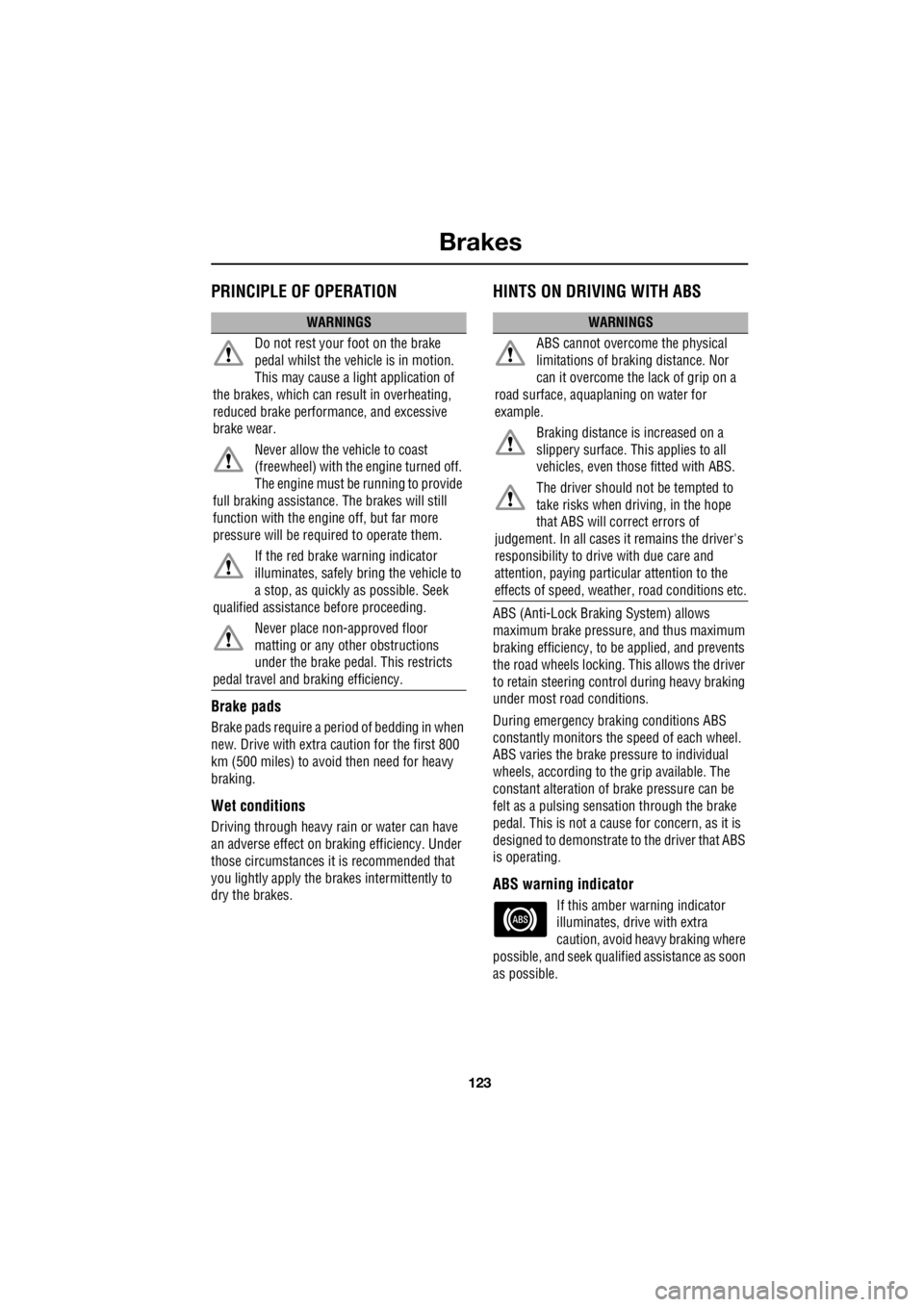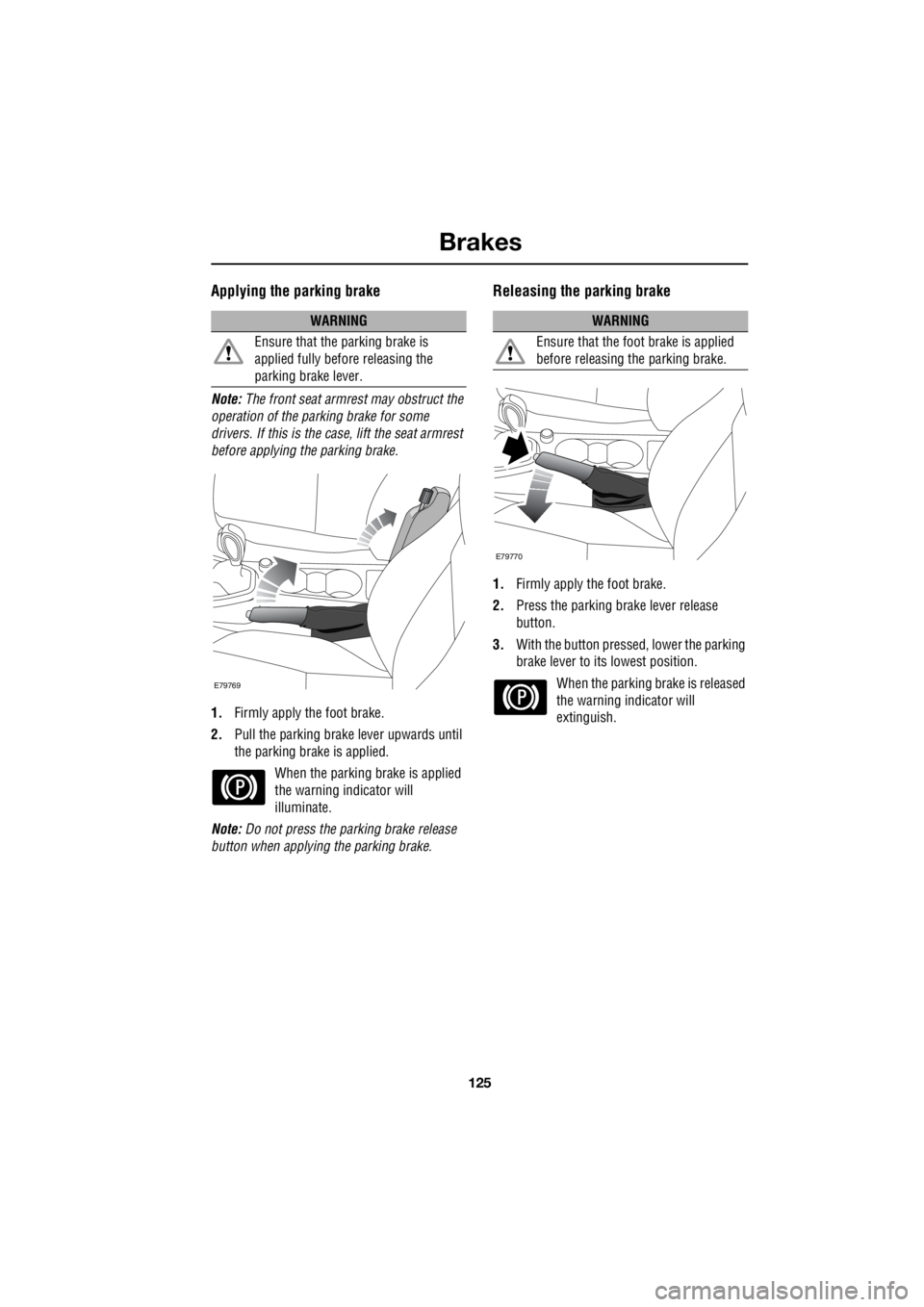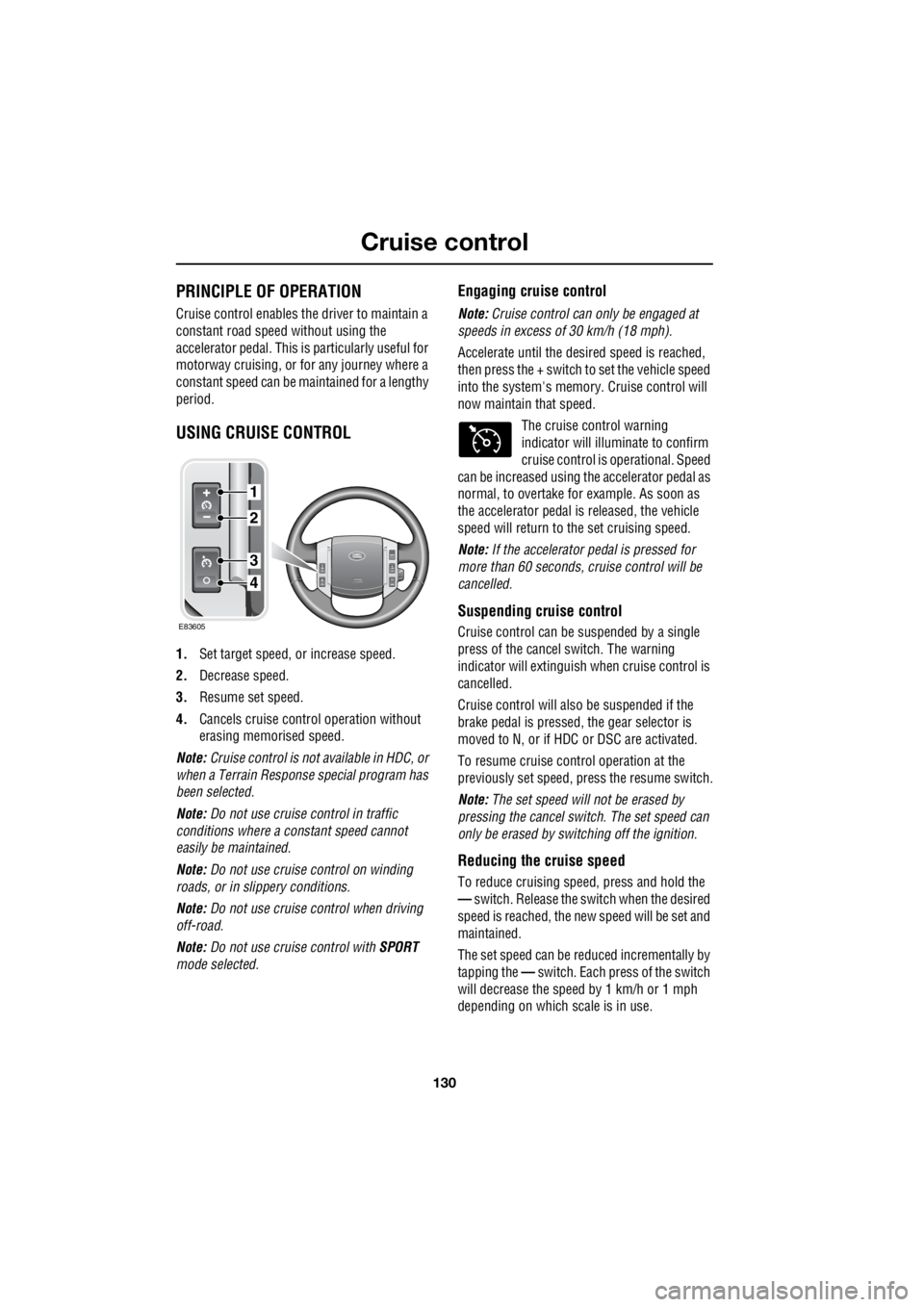2006 LAND ROVER FRELANDER 2 brake
[x] Cancel search: brakePage 2836 of 3229

Starting the engine
116
L
Stopping the engine
Before stopping the engine, ensure that the
vehicle is parked safely with the park brake
applied.
1. Select P (Park) and press the Start/Stop
button.
2. Press the remote to unlatch it, then remove
it from the docking port by gripping the
sides. Do not pull the remote out using the
keyring attachment as this will only
remove the emergency key.
DIESEL PARTICULATE FILTER (DPF)
The Diesel Particulate Filt er (DPF) forms part of
the emissions reduction system fitted to Land
Rover vehicles. The DPF will remove a high
proportion of the harmful carbon microspheres
(soot) before they leave the exhaust. It
achieves this by filter ing out the particles,
which are then stored until they are burnt away
and the filter is emptied.
Regeneration
Unlike a normal filter which requires periodic
replacement, the DPF has been designed to
regenerate, or clean itse lf to maintain operating
efficiency. The regene ration process takes
place automatically in most cases. However,
some unfavourable driving conditions mean
that the regeneration proc ess must be initiated
deliberately by the driver.
1
2
E81334
CAUTION
The regeneration procedure produces
high temperatures in the DPF. Heat can
be felt radiating from beneath the
vehicle, which is normal and not a cause for
concern. However, the vehicle should not be
parked over combustible material, particularly
during dry weather. The heat generated could
be sufficient to start a fire when in close
proximity to combustibl e material such as
long dry grass, paper etc.
Page 2839 of 3229

119
Transmission
R
Automatic mode
To select Drive (D) when the vehicle is
stationary :-
1. Apply the footbrake.
2. Press the gear selector release button.
3. Move the gear selector to Drive (D).
When in D the transmissi on will automatically
select the most appropriate gear for the current
driving conditions. Note:
If pressure is applied to the selector lever
before the foot brake is applied, any gear
selected may not be available irrespective of
the lever position. In th is situation, remove
pressure from the selector lever, ensure that
the footbrake is applied and select the required
gear.
Note: When a gear is selected the vehicle may
begin to move as soon as the foot brake is
released.
Kick-down
When D is selected, and the accelerator pedal
is depressed fully the transmission will
downshift to the lowest appropriate gear. Once
the accelerator pedal is returned to a normal
driving position the transm ission will upshift to
the highest appropriate gear.
Note: Kick-down operation will vary according
to road speed, current gear in use and
accelerator movement.
1
3
2
E81743
Page 2843 of 3229

123
Brakes
R
BrakesPRINCIPLE OF OPERATION
Brake pads
Brake pads require a period of bedding in when
new. Drive with extra caution for the first 800
km (500 miles) to avoi d then need for heavy
braking.
Wet conditions
Driving through heavy rain or water can have
an adverse effect on braking efficiency. Under
those circumstances it is recommended that
you lightly apply the brak es intermittently to
dry the brakes.
HINTS ON DRIVING WITH ABS
ABS (Anti-Lock Braki ng System) allows
maximum brake pressure, and thus maximum
braking efficiency, to be applied, and prevents
the road wheels locking. This allows the driver
to retain steering control during heavy braking
under most road conditions.
During emergency brak ing conditions ABS
constantly monitors the speed of each wheel.
ABS varies the brake pressure to individual
wheels, according to the grip available. The
constant alteration of brake pressure can be
felt as a pulsing sensat ion through the brake
pedal. This is not a cause for concern, as it is
designed to demonstrate to the driver that ABS
is operating.
ABS warning indicator
If this amber warning indicator
illuminates, driv e with extra
caution, avoid heavy braking where
possible, and seek qualified assistance as soon
as possible.
WARNINGS
Do not rest your foot on the brake
pedal whilst the vehicle is in motion.
This may cause a light application of
the brakes, which can re sult in overheating,
reduced brake performance, and excessive
brake wear.
Never allow the vehicle to coast
(freewheel) with the engine turned off.
The engine must be running to provide
full braking assistance. The brakes will still
function with the engine off, but far more
pressure will be required to operate them.
If the red brake warning indicator
illuminates, safely bring the vehicle to
a stop, as quickly as possible. Seek
qualified assistance before proceeding.
Never place non-approved floor
matting or any ot her obstructions
under the brake pedal. This restricts
pedal travel and braking efficiency.WARNINGS
ABS cannot overcome the physical
limitations of brak ing distance. Nor
can it overcome the lack of grip on a
road surface, aquaplaning on water for
example.
Braking distance is increased on a
slippery surface. This applies to all
vehicles, even those fitted with ABS.
The driver should not be tempted to
take risks when driving, in the hope
that ABS will correct errors of
judgement. In all cases it remains the driver's
responsibility to driv e with due care and
attention, paying partic ular attention to the
effects of speed, weather, road conditions etc.
Page 2844 of 3229

Brakes
124
L
ABS and off-road driving
ABS will operate when driving off-road,
however it may be unw ise to rely on it's
assistance under some conditions.
Stopping distances will be increased when
travelling over rough, or bumpy terrain.
Soft surfaces
On soft or deep surfaces such as powdery
snow, sand, or gravel, the braking distance
required will be increased. This is because the
natural action of a lock ed wheel (which cannot
happen when ABS is operating) is to form a
wedge of surface material in front of the wheel,
which reduces the stopping distance.
Steep slopes
If the vehicle is stationary on a steep, slippery
slope, it may begin to slide even with the
brakes applied. This is because without wheel
rotation the ABS cannot determine vehicle
movement.
To counteract this, briefl y release the brakes to
allow some wheel rota tion. Then re-apply the
brakes to allow ABS to gain control.
Emergency Brake Assist (EBA)
If the driver rapidly applies the brakes, EBA
automatically boosts the braking force to it's
maximum in order to bring the vehicle to a halt
as quickly as possible. If the driver applies the
brakes slowly, but condi tions mean that ABS
operates on the front wheels, EBA will increase
the braking force in order to apply ABS control
to the rear wheels.
EBA stops operating as soon as the brake pedal
is released.
A fault with the EBA system is
indicated by the red brake warning
indicator illuminating.
Electronic Brake Distribution (EBD)
EBD controls the balanc e of braking forces
supplied to the front and rear wheels, in order
to maintain maximum braking efficiency.
If the vehicle has a light load (only the driver in
the vehicle for example) the EBD will reduce the
braking force applied to the rear wheels. If the
vehicle is heavily laden then EBD will increase
the braking force to the rear wheels.
A fault with the EBD system is
indicated by the red brake warning
indicator illuminating.
PARKING BRAKE
Parking on a slope
Facing uphill
If the vehicle is parked facing uphill, select first
gear (manual gearbox), or Park (automatic
gearbox), and turn the steering wheel so that
the front wheels face away from the kerb.
Facing downhill
If the vehicle is parked facing downhill, select
reverse gear (manual gearbox), or Park
(automatic gearbox), and turn the steering
wheel so that the front wheels face towards the
kerb.
Page 2845 of 3229

125
Brakes
R
Applying the parking brake
Note: The front seat armrest may obstruct the
operation of the parking brake for some
drivers. If this is the case, lift the seat armrest
before applying the parking brake.
1. Firmly apply the foot brake.
2. Pull the parking brake lever upwards until
the parking brake is applied.
When the parking brake is applied
the warning indicator will
illuminate.
Note: Do not press the parking brake release
button when applying the parking brake.
Releasing the parking brake
1. Firmly apply th e foot brake.
2. Press the parking brake lever release
button.
3. With the button pressed, lower the parking
brake lever to its lowest position.
When the parking brake is released
the warning indicator will
extinguish.
WARNING
Ensure that the parking brake is
applied fully before releasing the
parking brake lever.
E79769
WARNING
Ensure that the foot brake is applied
before releasing the parking brake.
E79770
Page 2848 of 3229

Driving hints
128
L
Driving hintsGENERAL DRIVING POINTS
Battery charging - red
Illuminates as a bulb check when
the ignition is turned on and
extinguishes once the engine is
running. If it remains on, or illuminates whilst
driving, a fault with the battery charging
system is indicated. Seek qualified assistance
urgently.
Low oil pressure - red
Illuminates as a bulb check when
the ignition is turned on and
extinguishes when the engine is
started. If the indicator remains on, flashes on
and off, or illuminates whilst driving, stop the
vehicle as soon as safety permits and switch
off the engine immediat ely. Seek qualified
assistance before driving. Always check the oil
level when this indicator illuminates.
REDUCED ENGINE PERFORMANCE
Engine management syst em (EMS) fault
Illuminates amber in the
instrument pack when the engine
management system detects a
serious fault - reduce d performance may be
experienced. Avoid high speeds and consult
your Land Rover Dealer/A uthorised Repairer as
soon as possible.
Check engine - petrol models only
Illuminates amber in the
instrument pack as a bulb and
system check when the starter
switch is turned on and extinguishes as soon
as the engine is starte d. Illumination at any
other time indicates that the emission
performance of the engine management
system is impaired - seek qualified assistance.
If the indicator flashes while driving,
immediately reduce e ngine power to avoid
catalytic converter damage.
RUNNING-IN
The engine, gearbox, tyre s, and brakes need
time to bed-in. During the first 800 km (500
miles) it is essential th at the vehicle is driven
with consideration for the running-in process.
During the running in period the following
advice should be followed.
• Limit the engine speed to a maximum of
3000 rpm, and the road speed to a
maximum of 110 km/h (68 mph).
• Do not use full accelerator pedal travel, and
use the gears to avoid over-revving or
labouring the engine.
• Do not use sport mode during the running
in period.
• Avoid rapid accelerati on or heavy braking
wherever possible.
• Ensure that servicing is carried out on
time, and follow any advice regarding use
in arduous conditions.
Note: The advice given for running in will aid
fuel economy, and s hould be adopted as
general driving practice even after the running
in period.
Page 2849 of 3229

129
Driving hints
R
ECONOMICAL DRIVING
There are two main factors which influence fuel
economy, the way the vehicle is driven, and
maintenance.
Driving tips for economy
• Avoid unnecessary jour neys, especially
short stop-start trips.
• Accelerate smoothly and gently from a
stand still.
• Use the gears to avoid labouring, or
over-revving the engine.
• Allow time to brake gently and smoothly.
• Be aware of traffic and road conditions
ahead, and take action in time to avoid
hard braking or acceleration.
• When stationary apply the park brake, and
select neutral.
• Turn off the air conditioning when not
needed.
Maintenance and fuel economy
Regular servicing by a Land Rover
Dealer/Approved repairer, along with regular
checks by the driver are essential for vehicle
longevity and fuel economy.
The condition of the engine (oils, filters, spark
plugs, settings etc) tyre pressures, and wheel
alignment, will all have a bearing on fuel
economy. For this reason it is essential that the
vehicle is checked regularly by the driver, and
serviced by an approved Land Rover
Dealer/Authorised Repairer at the correct
intervals.
Note: If you are in any doubt about the
maintenance requirement s, intervals, or
checks required, contact your Land Rover
Dealer/Authorised repairer for advice.
Page 2850 of 3229

Cruise control
130
L
Cruise controlPRINCIPLE OF OPERATION
Cruise control enables the driver to maintain a
constant road speed without using the
accelerator pedal. This is particularly useful for
motorway cruising, or for any journey where a
constant speed can be maintained for a lengthy
period.
USING CRUISE CONTROL
1. Set target speed, or increase speed.
2. Decrease speed.
3. Resume set speed.
4. Cancels cruise contro l operation without
erasing memorised speed.
Note: Cruise control is not available in HDC, or
when a Terrain Respons e special program has
been selected.
Note: Do not use cruise control in traffic
conditions where a constant speed cannot
easily be maintained.
Note: Do not use cruise control on winding
roads, or in slippery conditions.
Note: Do not use cruise control when driving
off-road.
Note: Do not use cruise control with SPORT
mode selected.
Engaging cruise control
Note: Cruise control can only be engaged at
speeds in excess of 30 km/h (18 mph).
Accelerate until the desired spee d is reached,
then press the + switch to set the vehicle speed
into the system's memory. Cruise control will
now maintain that speed.
The cruise control warning
indicator will illuminate to confirm
cruise control is operational. Speed
can be increased using th e accelerator pedal as
normal, to overtake fo r example. As soon as
the accelerator pedal is released, the vehicle
speed will return to the set cruising speed.
Note: If the accelerator pedal is pressed for
more than 60 seconds, cruise control will be
cancelled.
Suspending cruise control
Cruise control can be suspended by a single
press of the cancel switch. The warning
indicator will extinguish when cruise control is
cancelled.
Cruise control will also be suspended if the
brake pedal is pressed, the gear selector is
moved to N, or if HDC or DSC are activated.
To resume cruise cont rol operation at the
previously set speed, press the resume switch.
Note: The set speed will not be erased by
pressing the cancel switch. The set speed can
only be erased by switching off the ignition.
Reducing the cruise speed
To reduce cruising speed, press and hold the
— switch. Release the switch when the desired
speed is reached, the ne w speed will be set and
maintained.
The set speed can be reduced incrementally by
tapping the — switch. Each press of the switch
will decrease the spee d by 1 km/h or 1 mph
depending on which scale is in use.
1
E83605
2
3
4